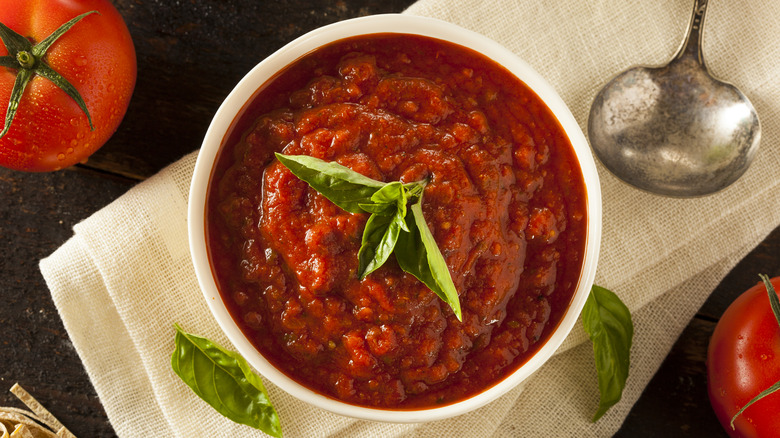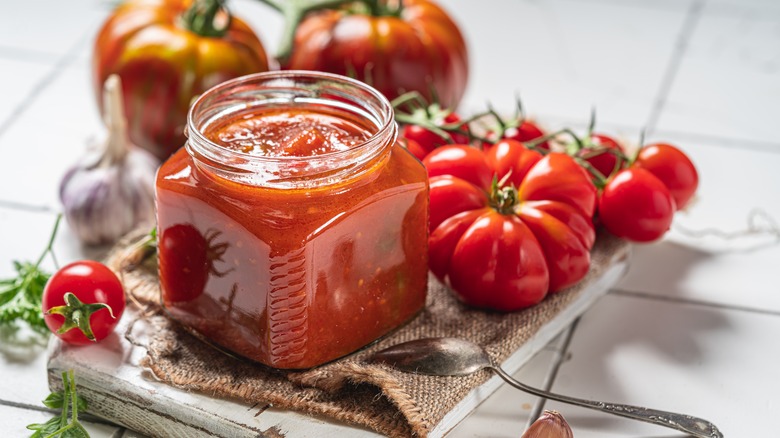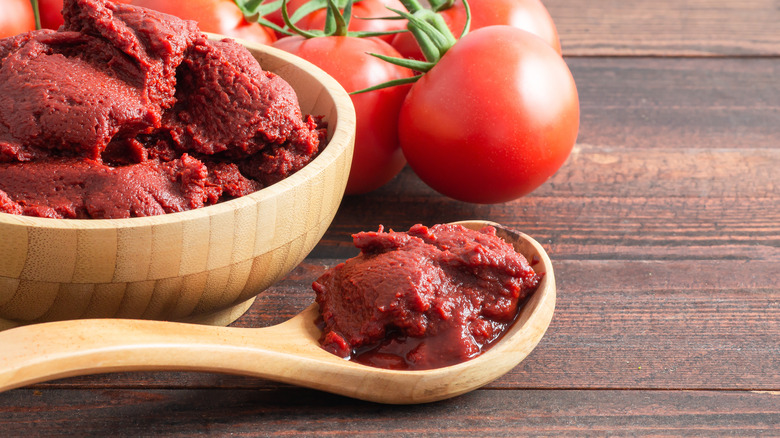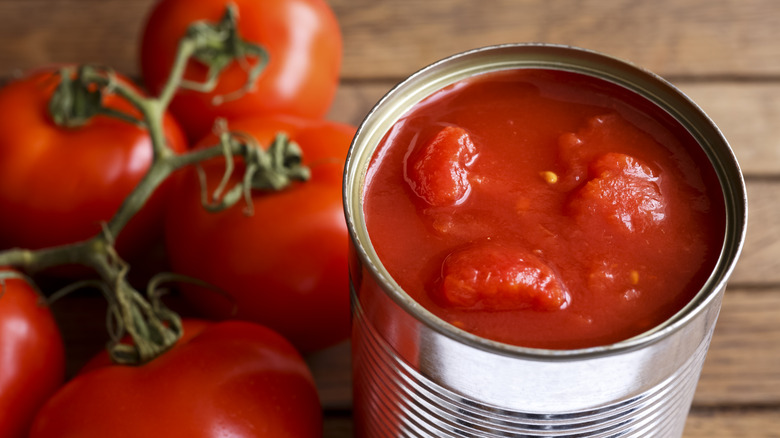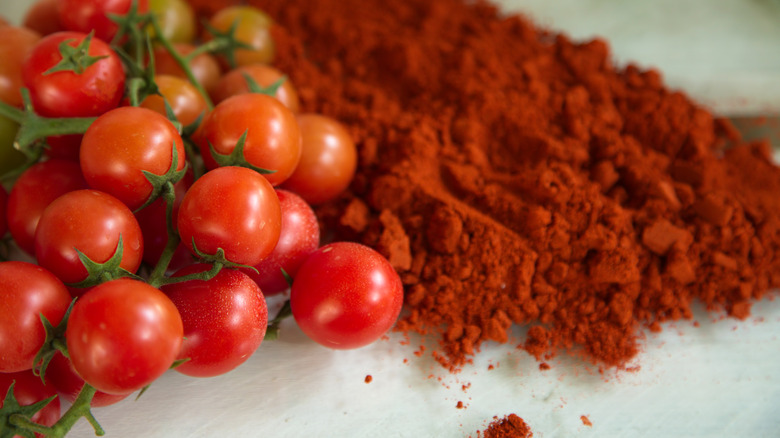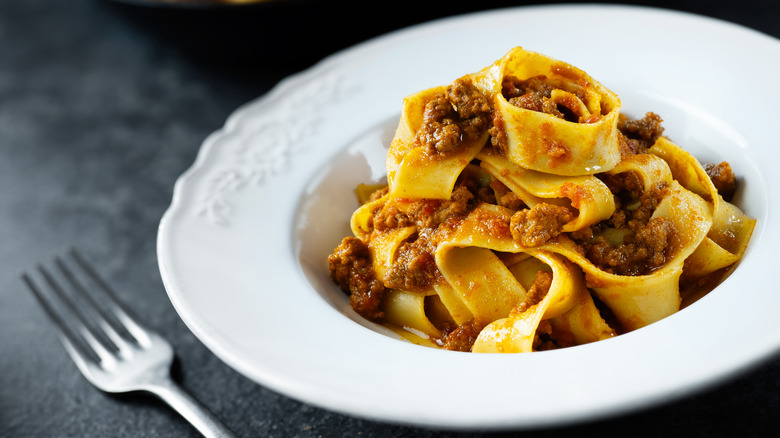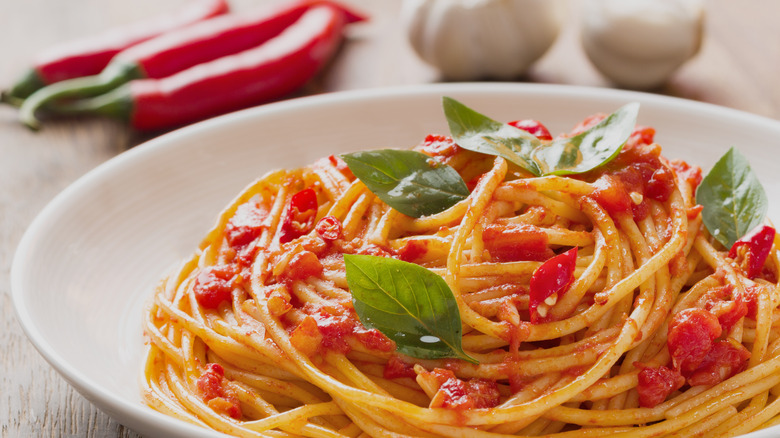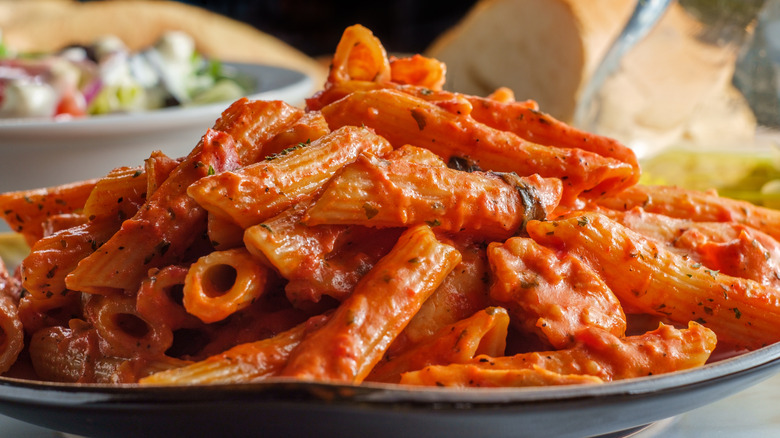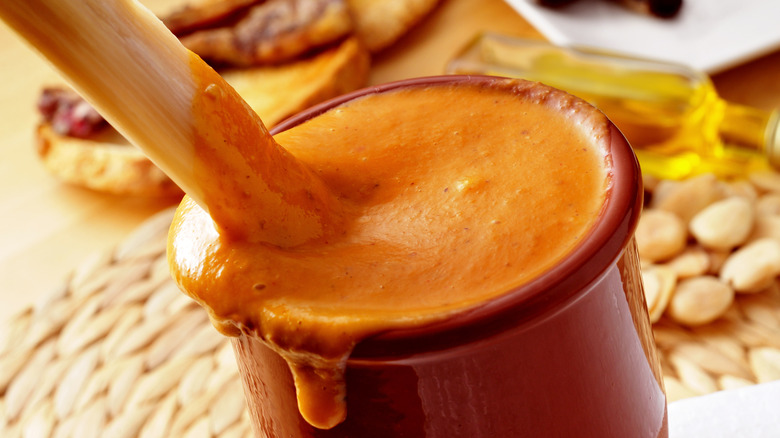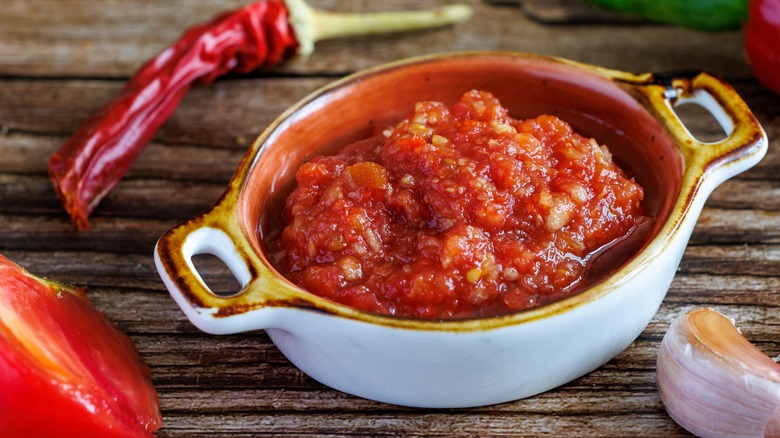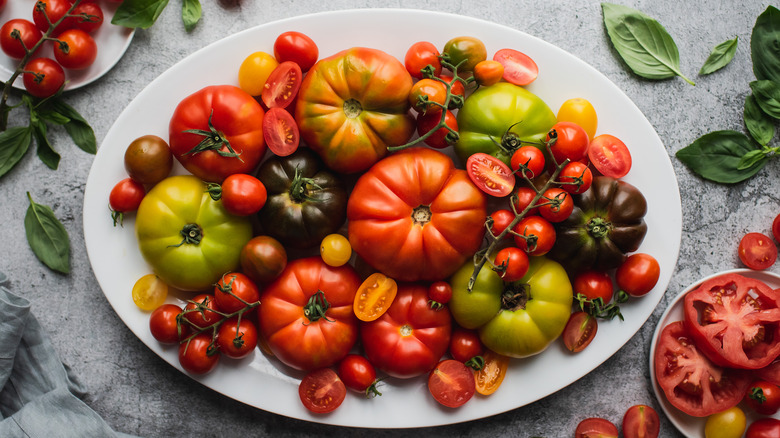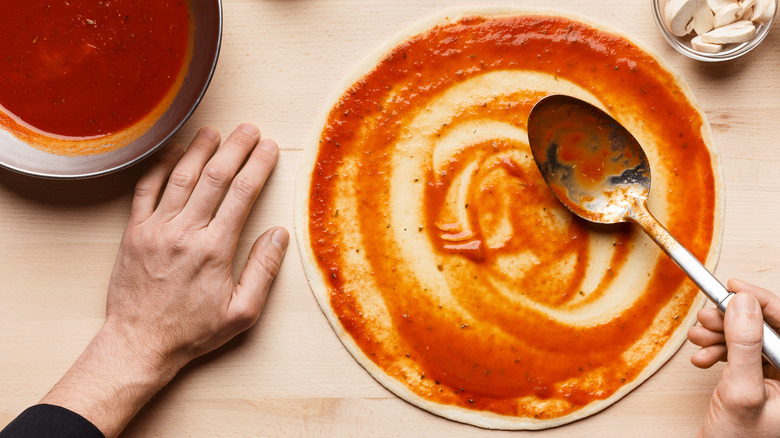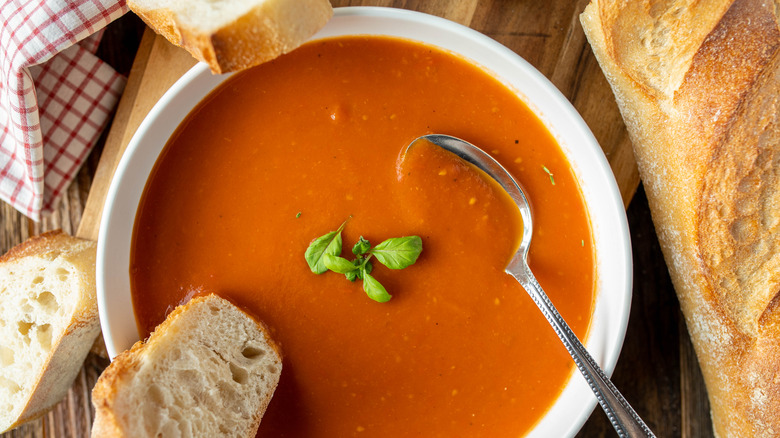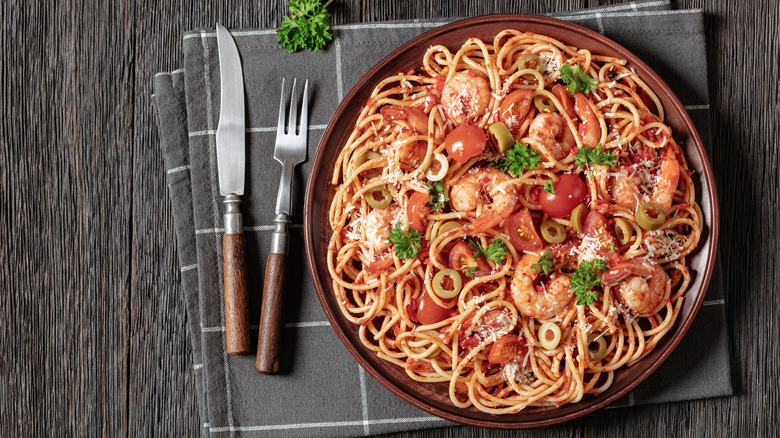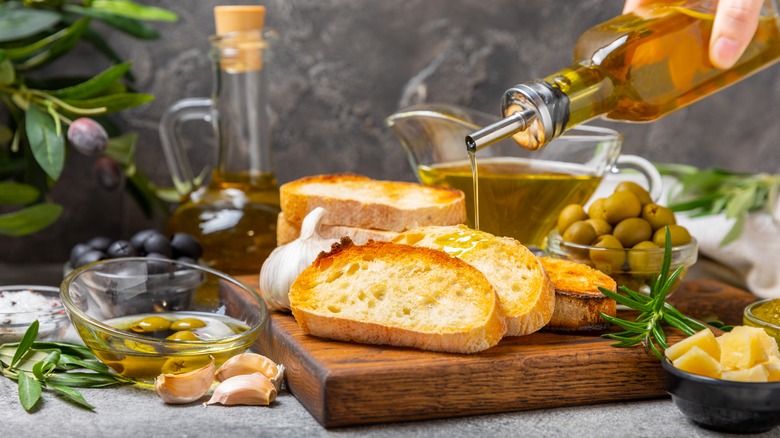14 Substitutes For Marinara Sauce You Should Know
Marinara sauce is a classic sauce used on popular pasta dishes around the world. If you head to your favorite Italian restaurant and order spaghetti and meatballs, it will likely be topped with marinara sauce. It is quick and easy to make, with a simplified ingredient list that, at its most basic, includes tomatoes, salt, and pepper, although you may also see it made with onions, basil, and garlic. Marinara sauce is versatile making it a common sauce that we see on everything from pasta to pizza.
Marinara sauce is easy to make at home or choose from various versions at the grocery store. You can even make hybrid marinara by starting with a jar of your favorite brand from the supermarket and adding your own special twist at home with fresh herbs or added veggies.
But what if you're all out of marinara sauce or want to change up a classic dish? You have lots of options. I've been developing recipes for nearly a decade as a recipe creator and food blogger. Let's look at some substitutes for marinara sauce that won't skimp on flavor.
Tomato sauce
Tomato sauce is a simple, pureed sauce with mild spices that can be purchased pre-made or whipped up in a home kitchen. Because the flavors are so similar to marinara sauce, it's a great substitute for any recipe that calls for marinara. Tomato sauce is commonly made with fresh or canned plum tomatoes. You can add other vegetables (carrots and onions make great pasta sauce additions), but traditionally tomato sauce is made with minimal ingredients. The emphasis should be on fresh ingredients and flavors.
Tomato sauce is usually seasoned with garlic, oregano, and basil, but there's no need to confine yourself to those three ingredients. You can add any spice calling your name to your tomato sauce recipe. If you make a large batch of sauce, you can store the leftovers in the fridge and save them for another delicious dinner later in the week. You can freeze it if you don't think you'll get to it that week. Tomato sauce works interchangeably with marinara sauce in most cases, making this a great substitute for pasta dishes and pizza.
Tomato Paste
With a thick texture and a rich, concentrated flavor, tomato paste is a pantry staple. You likely have some in your pantry right now, and with just a little bit of effort, you can turn it into the perfect substitute for marinara sauce. Available in a small can or tube, tomato paste is made from tomatoes that have been cooked, strained, and cooked again. The end result is a super thick and condensed paste that really packs a punch in the flavor department. Tomato paste is usually made from paste tomatoes, which are low in moisture and are ideal tomatoes for making sauces. Tomato paste is lightly seasoned, if at all, so you can add your favorite spices to the mix when you make your sauce.
Most recipes that use tomato paste only call for a small amount as the flavor is so concentrated. If you're subbing our marinara for tomato paste, you'll use one tablespoon of tomato paste for every three tablespoons of marinara. Keep in mind you'll also need to add more liquid to your tomato paste, as it's much thicker than marinara sauce. Make sure you keep that tomato paste on-hand when you're done with it. Tomato paste is a handy ingredient to have around, and there are many ways you can use it.
Canned tomatoes
Odds are good that you have a can or two of tomatoes in your pantry (probably hiding right between the tomato paste and the tomato sauce). Turning those canned tomatoes into a delectable pasta sauce doesn't take much. Canned tomatoes are a fabulous option when fresh tomatoes are out of season. Plus, you'll can find a variety of canned tomatoes at your local grocery store. While any brand of canned tomato will do, San Marzano tomatoes are a traditional favorite for pasta sauces.
Canned tomatoes are a great starting point for a homemade marinara sauce. If you're missing the ingredients for traditional mariana or if you just want to try something different, let your culinary creativity take the wheel. Turn those canned tomatoes into your pasta dream sauce, making it as thick, chunky, or smooth as your palate desires.. Think of canned tomatoes as a blank slate. Add your favorite spices and vegetables, like crushed chili flakes and fresh basil, for homemade sauces that to level up your lasagna and elevate your pasta dishes.
Tomato powder
Tomato powder is a pantry's best-kept secret. Simply dehydrated tomato, this powder is versatile and user-friendly and can be turned into an amazing substitute for marinara sauce. It's also a great addition to your existing sauce recipes. Think of tomato powder as tomato paste — you have to add the water. To turn this magical powder into a usable tomato paste, simply add 2 tablespoons of water to 1 tablespoon of powder, and voila! You have a usable tomato paste that could likely become your next favorite sauce.
You can also use tomato powder as a flavor booster by mixing a little into an existing sauce recipe (or even adding it to store-bought sauce) for an extra zing of tomato flavor. You'll never run out of ways to use this handy ingredient. And in case you need more convincing, tomato powder also has a long shelf life. An unopened jar will stay good for eight years. Next time you're at the store, grab a jar to keep around for marinara sauce replacement emergencies.
Bolognese sauce
Bolognese is a meat-based sauce loaded with tomatoes, onions, and herbs that adds protein and some hearty umami flavor to your meal, making it perhaps a step up from a basic marinara sauce. While the ingredients in Bolognese sauce can vary from recipe to recipe, it usually includes ground meat and vegetables like celery, carrots, onions, tomatoes, white wine, and milk. You may not find milk in all Bolognese sauce recipes, but traditional recipes always include it. Milk balances out the acidity of the tomatoes and the wine, resulting in a creamier sauce.
Ground beef is a popular selection for Bolognese sauce, but it's not your only choice. Ground pork is another tasty option. If you're trying to reduce fat and calories, you can also go for a ground turkey Bolognese recipe.
Bolognese is a versatile sauce that pairs well with many kinds of pasta, but in Italy, you'll most often find it served with tagliatelle, an egg pasta. Bolognese works best when served with noodles that have some real estate and are wide enough to hold the sauce. Fettuccine is another great option, but spaghetti noodles are too thin and round — the sauce will slide right off the noodles.
Arrabbiata sauce
Some like it hot, and if you're looking to spice it up, try substituting your marinara sauce for an Arrabbiata sauce. This spicy tomato sauce is made with garlic and red chili peppers and can turn your average lasagna into something you'll remember. Arrabbiata sauce, which comes from the Lazio region of Rome, translates to "angry" because of its spice levels — but despite the name, it's been making tastebuds happy since the 1950s.
Many ingredients in Arrabbiata sauce (tomatoes, herbs, and mild spices) match those in a typical marinara sauce. The addition of dried red chili peppers is where this sauce takes a turn from mild to hot, and depending on how heavy-handed you are with the chilis, this sauce can really turn up the heat.
Arrabbiata sauce is a kicky substitute for marinara sauce on pasta dishes, over meat, and even as a dipping sauce. Try swapping out your chicken marinara for chicken Arrabbiata, using it to make spicy meatballs, or even use it in place of your usual pizza sauce.
Vodka sauce
A creamy tomato sauce made with vodka and heavy cream, also makes a rich and delicious topping for your favorite proteins. You'll never miss the marinara when you pour vodka sauce over your meatballs or Italian sausage.
Vodka sauce is usually somewhere between pink and orange in color, and it's famous for its soft, silky texture. You don't taste the vodka in this sauce, as only a very small amount is used. The purpose of the vodka is not related to flavor but to help maintain the sauce's texture by working as an emulsifier for the heavy cream and tomatoes.
Use vodka sauce the next time you make penne pasta, swap out your usual pizza sauce for a vodka sauce, or add it as a topping to your favorite protein. Vodka sauce beautifully complements chicken or shrimp, and is delicious with Italian sausage.
Romesco sauce
Romesco sauce, which comes from Spain, can vary widely from recipe to recipe, but is usually made from roasted red peppers, tomatoes, nuts, and olive oil. This flavor-forward sauce goes well with pasta or rice, and can be used as a dip for breadsticks or cheese sticks, making it a unique swap for marinara sauce. Its smoky essence makes it stand out amongst sauces, and it can be easily modified for more heat if you have a hankering for something spicy.
Romesco sauce is thick and hearty, making a great dressing for fish, chicken, and vegetables. Romesco sauce takes a little more effort than a simple tomato sauce, but the results are well worth it. Homemade romesco sauce is delicious, and you'll find yourself using it as a sauce or topping for any traditional recipe that calls for marinara. But with its strong, smoky flavor, you may also find yourself using it for your outside-of-the-box kitchen creations.
Salsa
Try something off-the-beaten path when you swap out your traditional marinara sauce and typical pasta ingredients for a little south-of-the-border flair. If you've never substituted salsa for marinara this is your chance to get creative in the kitchen and blend Italian and Mexican cuisines into something unforgettable.
Made with tomatoes, onions, and garlic, salsa shares many similar ingredients to marinara and tomato sauces around the world. However, salsa adds some different flavors by including cilantro and jalapeño, which can be modified to your taste buds and spice preferences. Salsa also differs from marinara sauce in that it can be served cooked or raw, while marinara sauce is always cooked.
Salsa is one very versatile sauce. Turn it into your new favorite pasta dressing, or use it as a dip for cheese sticks. It's also amazing for saucing your steak, fish, or chicken and can be added to wraps and sandwiches.
Fresh tomatoes
Instead of reaching for a jar of marinara sauce, try making pasta sauce from scratch using fresh tomatoes. You might think that making a homemade pasta sauce from scratch is time-consuming and not worth the effort, but the opposite is true. Homemade pasta sauces can be very easy to make, and the flavor can't be beaten — plus, the aroma you get when you walk into the kitchen will make the whole household happy!
Making your own tomato sauce is also an efficient way to use up a bountiful tomato harvest. It's even better if you add some fresh herbs from the garden. And, don't be afraid to toss in some veggies, too. Carrots, onions, celery, and zucchini all make for great tomato sauce additions.
You can use any tomatoes for homemade tomato sauce, although some common favorites are San Marzano and paste tomatoes like Roma or plum tomatoes. You can store your homemade sauce in the fridge for four or five days. Or, you can freeze it. Frozen pasta sauce will last up to six months.
Pizza sauce
Pizza sauce and pasta sauce share many of the same ingredients, but they're quite different. However, if pizza sauce is all you have around, you can make a few modifications to create a passable sauce that will work as a substitute for marinara.
While the ingredients may be similar, pasta sauce is always cooked. Pizza sauce, however, is not cooked. It gets its flavor as the ingredients meld together over time. Pizza sauce does get cooked, however, when you put the pizza in the oven. So, you'll need to make a few tweaks to make pizza sauce work as a marinara replacement.
Start by sautéing chopped onion and diced garlic with extra virgin olive oil. Once the onions and garlic have turned translucent, add your pizza sauce to the pan. Stir and let it simmer until the flavors have blended. This will transform your pizza sauce from plain to something with a little pizazz that is more suited to pasta.
Store-bought pizza sauce often comes in jars, and there are often sauce leftovers after making a pizza. Turning your pizza sauce into pasta sauce is a great way to use the leftover sauce.
Tomato soup
It might sound strange, but you can use soup as a marinara substitute. While there aren't any hard and fast rules about which soups to use, sticking to tomato soup will give you the closest result to a traditional marinara dish (tomato soup makes for a tasty addition to your boring old boxed mac and cheese recipes, too).
Soup is already similar in texture to many sauces, making it a simple swap for marinara. While boiling your pasta noodles, heat the soup on the stove until it bubbles. Once the pasta has been cooked and drained, add it to the soup and toss until it is fully coated with the soup. Add some grated parmesan cheese to your pasta for a nice finishing touch.
If you're making a big batch of soup, this is a great way to serve up the leftovers. And because soup is generally freezer-friendly, you can always freeze your leftover soup and turn it into a pasta sauce at a later date.
Fra diavolo
Sometimes, you just need things a little extra spicy, and if that's the case for you, look no further than fra diavolo sauce. If you likey the spicy, this sauce can be an exciting alternative to marinara. Fra diavolo is commonly made with similar ingredients to marinara, although some recipes may swap out the tomatoes completely in exchange for chicken stock. What is not the same, though, is that fra diavolo is often made with crushed red pepper flakes (or, in some recipes, sriracha or other hot sauces).
Fra diavolo, translates from Italian to "brother devil," but the sauce is uniquely American. It's popular on shellfish (you've likely heard of lobster fra diavolo before, or perhaps seen a shrimp and fettuccine fra diavolo recipe). This sauce is great for dressing any protein that would benefit from a little kick. It also makes a fun topping for crab cakes, and a spicy dip for veggies or cheese sticks.
Olive oil, salt, and pepper
If you lack any of the ingredients you need to make marinara sauce, keep it simple but far from basic by dressing your pasta with real extra virgin olive oil and a sprinkle of salt and pepper. Olive oil is an excellent dressing for any pasta dish, from rotini to ravioli. It also makes a great dipping sauce for crusty sourdough bread (add a little splash of balsamic vinaigrette for the ultimate bread dip).
You won't get the sweet and tangy flavor you would from a tomato-based sauce, but olive oil brings unique flavors to the table. When it comes to pasta, pizza, and protein, olive oil is always the right choice. Olive oil adds a fresh flavor and velvety feel to your meal. It doesn't take much, either. Try using just a few teaspoons of olive oil over your serving of pasta. Sprinkle in a little salt and pepper and toss until the pasta is coated in the olive oil. It's easy to add more if you so desire, but a little olive oil goes a long way.
